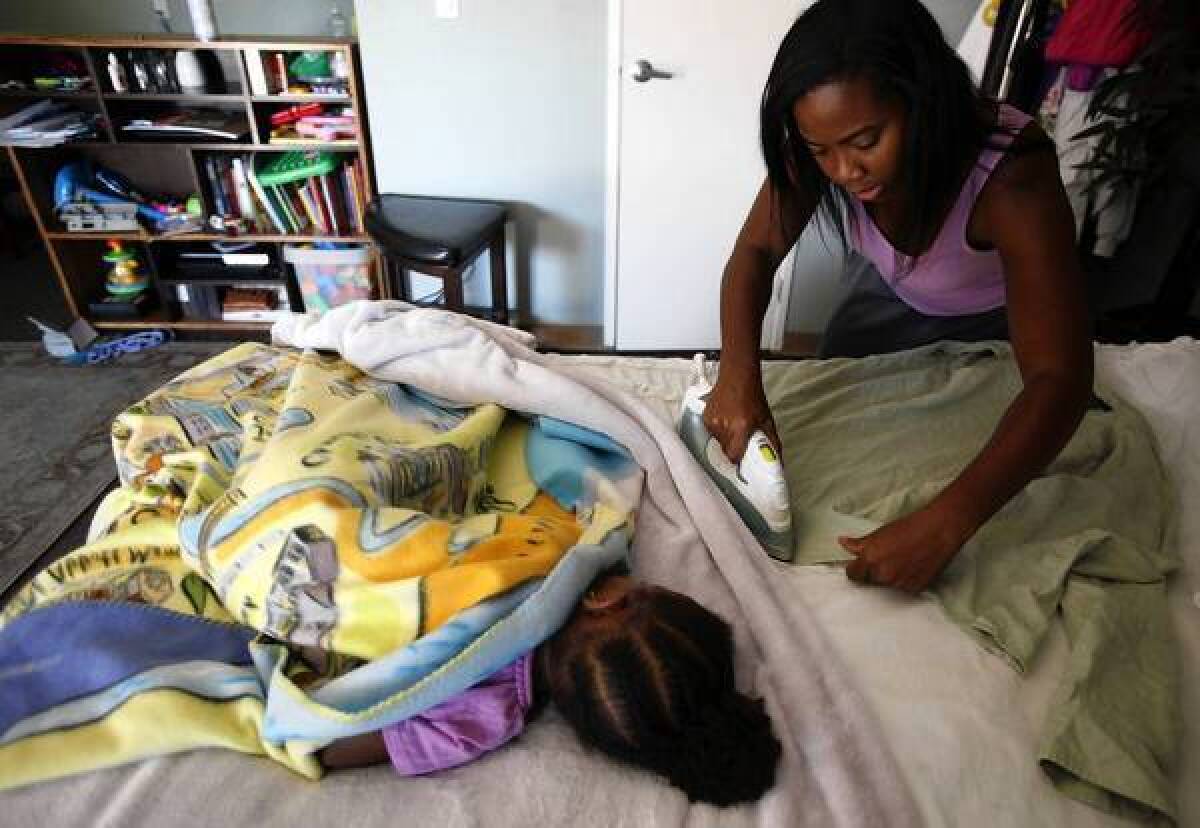Food stamp cuts kick in, affecting about 47 million

- Share via
Some 47 million poor Americans who rely on food stamps for their meals will have to get by on less, after their benefits were cut Friday.
In California, which struggles with nearly 9% unemployment, local officials are girding for the fallout after the benefit for a family of four receiving food stamps was lowered by $36 a month.
About 4.2 million Californians are affected by the drop in benefits, including more than 1.1 million residents of Los Angeles County. And many local businesses will be hurt as well, because California’s food stamp recipients will be spending $46million less per month in local stores.
“The impoverished are forced to eat junk if we want to eat,” said 32-year-old Tabitha, a mother of a 2-year-old and a 7-year-old staying at a Culver City shelter, who asked that her last name not be used because she said she was embarrassed. “It’s going to be difficult, as it already has been.”
The cut was triggered by the expiration of stimulus spending Congress approved in the depths of the Great Recession. It is unlikely to be the last; in Washington, the House and Senate are trying to reconcile measures each approved that would reduce food stamp spending by billions of dollars more.
Friday’s benefit reduction was meant to coincide with a brightening economy, yet many Americans remain stuck in poverty despite improvements from the worst of the recession.
“I think it’s a horrible thing,” said Najuah Mudahy, 30, also of the Culver City shelter, a food stamp recipient who works two jobs, as a clerk at a shoe store and a hostess at a California Pizza Kitchen. Both bring in $9 an hour. Mudahy said she runs out of money to keep her 3-year-old daughter fed before the end of every month, even on dinners of canned soup.
“It only forces people to do desperate things,” she said of the cuts.
Food aid advocates say there are millions in similar predicaments and have implored Congress to stop seizing on the program for budget trims.
Even before Friday, government statistics show, the benefit fell short of keeping those on food stamps well-nourished. In California, the monthly allocation for a family of four with no income has now dropped to $632. The benefit varies around the country, based on the cost of living.
About 14% of Americans are on food stamps. The program has grown rapidly in recent years, attracting the attention of deficit hawks, who note it now costs taxpayers $75 billion a year.
Legislation approved by the Republican-led House could lead to nearly 2 million Americans losing access to the program, according to congressional analysts. California legislative leaders warn that the number could be considerably higher, projecting in a letter to members of Congress last week that half a million Californians would be booted from the program if the House measure were to become law.
The cut approved by the Democratically controlled Senate would be much smaller, reducing the program by $4 billion over the next 10 years as compared to the $40-billion cut approved by the House.
Obama administration officials say the reductions that went into place Friday are certain to result in missed meals for those enrolled. There are seven million Americans for whom food stamps is the only source of income, according to Kevin Concannon, undersecretary for food, nutrition and consumer services at the U.S. Department of Agriculture.
The cut “is a huge challenge for those households,” he said. Local food banks, Concannon said, are not positioned to serve as backstops.
“It would be like asking someone running a marathon with a 100-pound pack on their back to take on another couple hundred pounds,” he said. “They don’t have the capacity to do this.”
At the Alameda County Community Food Bank, one of the largest in the San Francisco Bay Area, officials say making up for the cut that took effect Friday would require the organization to provide about 5.5 million additional meals per year.
“This isn’t about taking some luxury items out of your food budget,” said Michael Altfest, a spokesman for the food bank.
“For most people receiving this, it is their only source of nutrition for themselves and their families. This is a lot of food. It is many meals.”
Officials in other big states are also alarmed.
In Texas, about 4 million people receive food stamps each month, a dramatic increase from 2.5 million five years ago. The latest cuts will drain $411 million from the state economy, said Celia Cole, chief executive of the Austin-based Texas Food Bank Network.
“That’s a big hit for the state,” she said. While many Texans have bounced back from the recession, she said, “the number of people living in poverty has not changed — things haven’t gotten better for them yet.”
The effect of the cuts, experts say, goes beyond those who receive food stamps. The USDA estimates that every $5 spent on food stamps generates $9 in economic activity.
“It affects the whole supply chain of stores, the number of employees they have, the suppliers of goods,” said Patrick Burns, a senior researcher at the Economic Roundtable, a Los Angeles-based research group. “Those ripple effects go through the economy.”
Halper reported from Washington and Chang from Los Angeles. Times staff writers Kate Linthicum in Los Angeles and Molly Hennessy-Fiske in Houston contributed to this report.
More to Read
Sign up for Essential California
The most important California stories and recommendations in your inbox every morning.
You may occasionally receive promotional content from the Los Angeles Times.















